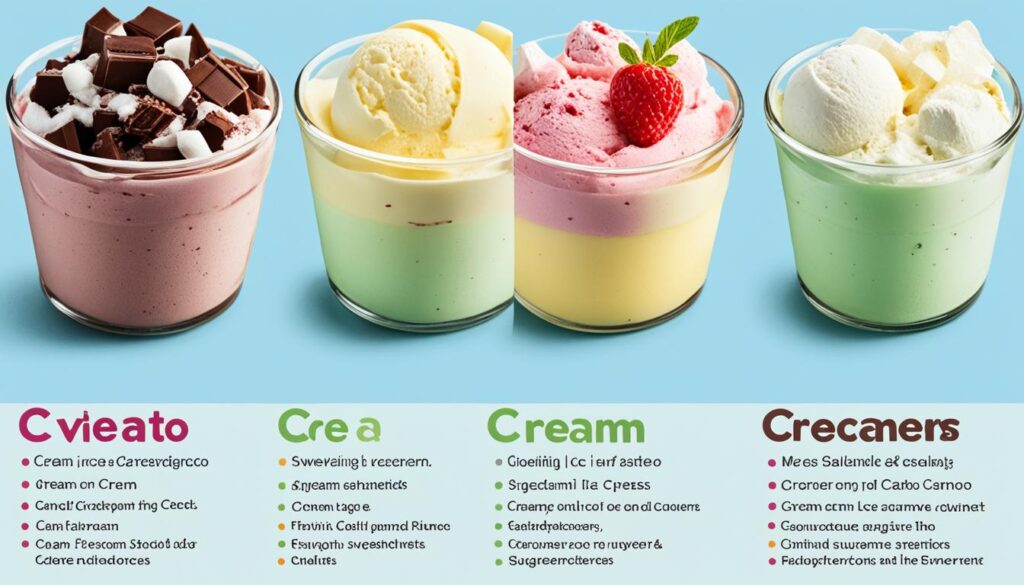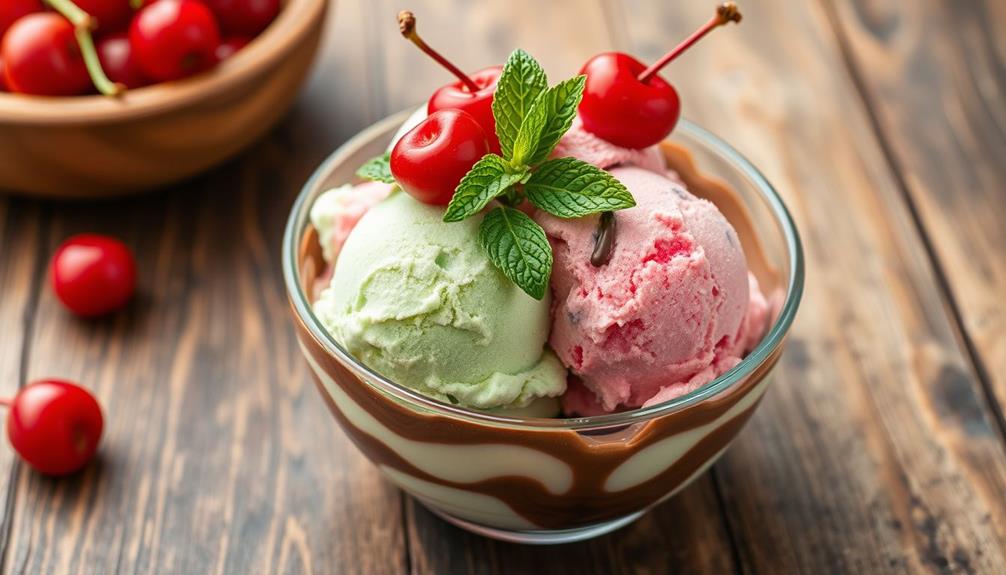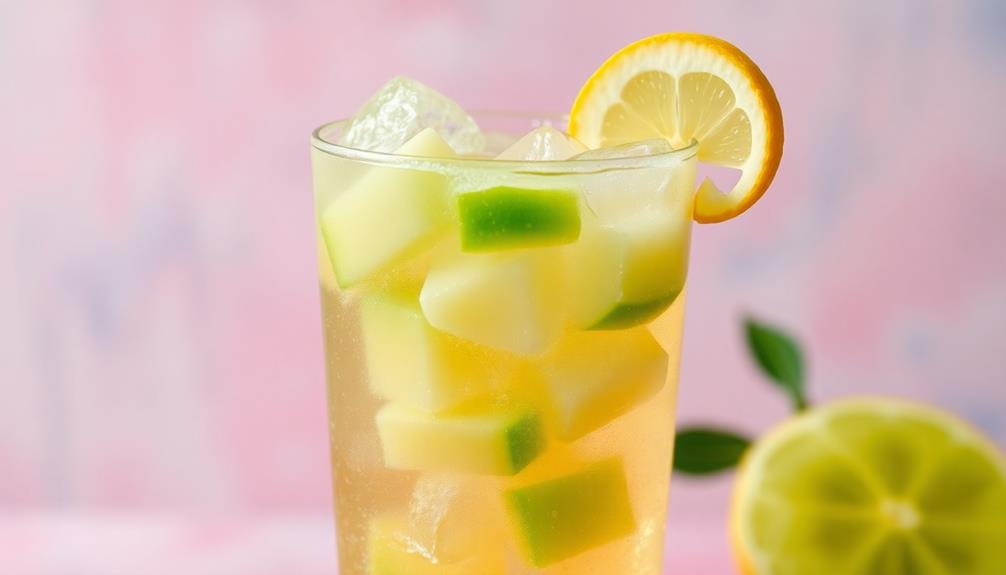Imagine it’s a hot summer day, and you find yourself reaching for a cool scoop of your favorite ice cream. The simplicity of this moment often belies the complexity of what truly goes into that creamy delight. Do ice creams contain eggs? This question lingers in the minds of many, especially those conscious of their dietary choices or those navigating the challenges of an egg allergy. Understanding the ice cream ingredients is essential—not just for your taste buds, but for your health too. Join us on this journey as we unravel the delicious secrets behind your beloved frozen treat.
Key Takeaways
- Eggs can enhance creaminess and flavor in ice cream recipes.
- Not all ice creams contain eggs; egg-free options are widely available.
- Checking ice cream ingredients is crucial for those with an egg allergy.
- Ice cream requires at least 10% milk fat to meet FDA standards.
- Both traditional and modern ice cream production methods exist.
Introduction to Ice Cream Ingredients
Understanding the components that make up ice cream can enhance your appreciation for this beloved treat. The primary ice cream ingredients contribute to the delightful flavors and textures that people enjoy around the world.
The primary components of ice cream
The foundation of ice cream typically includes a few critical ingredients. Key components often consist of:
- Dairy products, such as cream and milk
- Sugars, which add sweetness
- Stabilizers and emulsifiers for texture improvement
These common ingredients in ice cream create a balance that supports a wide range of flavors. The quality and proportions of these ingredients can significantly impact the final product. Understanding these elements helps you realize how complex and delicious creamy ice cream can truly be.
What makes ice cream creamy and delicious
The creaminess of ice cream comes primarily from the fat content, influenced by the balance of cream and milk. Air is another essential factor, incorporated during churning, which gives ice cream its light and airy mouthfeel. Additionally, variations in sugar content can affect both the flavor and texture. For a rich experience, many enjoy custard-based French-style ice cream that includes egg yolks as emulsifiers, enhancing the creamy quality.

| Ingredient | Function |
|---|---|
| Milk | Base liquid for texture and flavor |
| Cream | Adds richness and creaminess |
| Sugar | Sweetness and enhances flavor |
| Stabilizers | Improve texture, prevent ice crystal formation |
| Emulsifiers | Help blend ingredients, improve mouthfeel |
Grasping these aspects of ice cream ingredients makes enjoying this dessert even more enjoyable. Each element plays a role in creating the perfect scoop, be it a rich custard or a lighter Philadelphia-style flavor.
Are There Eggs in Ice Cream?
When creating a delicious and creamy ice cream, the choice of ingredients plays a critical role. Among these ingredients, eggs have significant importance. Understanding whether there are eggs in ice cream can help you navigate your options, especially if you have dietary restrictions.
Understanding the role of eggs in ice cream production
Egg yolks contribute to the texture and flavor of ice cream, enhancing its richness. They act as emulsifiers, blending fat and liquid components, which results in a smoother consistency. In traditional custard-based recipes, eggs often play a pivotal role. The average ratio ranges from two egg yolks per quart to as many as ten, depending on the desired creaminess. Renowned chefs like David Lebovitz frequently use around five egg yolks in their recipes, highlighting the preference for a creamier result.
If you’re curious about ice cream ingredients, many brands offer options both with and without eggs. For those who enjoy a denser and smoother texture, opting for recipes rich in egg yolk is ideal. Still, not all ice creams include eggs; premium brands like Jeni’s use alternative methods, including a specialized pasteurization process, to achieve their distinctive flavor without the need for egg yolks.
Common ice cream ingredients that may include eggs
It’s important to check the labels when shopping for ice cream, especially if you have an egg allergy. Some common flavors, especially vanilla or custard varieties, may still contain egg yolk, impacting your choices. Here’s a helpful table to overview typical ice cream ingredients:
| Ingredient | Presence of Eggs | Function |
|---|---|---|
| Dairy | No | Provides creaminess and base flavor |
| Sugar | No | Sweetens the mixture |
| Egg Yolk | Yes | Enhances richness and texture |
| Stabilizers (e.g., guar gum) | No | Improves texture |
| Alcohol | No | Softens texture; can affect stability |

Whether you prefer the creaminess that egg yolks provide or you’re looking for egg-free options, understanding the role of these ingredients can elevate your ice cream experience. As a consumer, being informed about ingredient choices allows you to align your preferences with your dietary needs.
Egg-Free Ice Cream Options
If you’re looking to enjoy ice cream without the inclusion of eggs, several brands cater to your needs. Many of these options are not only delicious but also provide various flavors to keep your taste buds satisfied. You’ll find that brands without eggs often highlight their vegan or dairy-free certifications, making them appealing to a broader audience.
Brands that produce egg-free ice cream
Some popular brands producing egg-free ice cream include:
- Planet Oat: Known for its rich flavors, with their Vanilla being particularly well-rated.
- So Delicious: Offers a variety of flavors, including their Vanilla Wondermilk.
- McConnell’s: Their Lemon Swirl vegan ice cream balances refreshment with flavor.
- Ben & Jerry’s: Their Non-Dairy Strawberry Cheezecake delivers fresh strawberry flavor without artificial tastes.
- Jeni’s: Offers a range of options, including Chocolate-Coconut with chocolate cake pieces.
- Breyers: Their Non-Dairy Vanilla is a budget-friendly choice that mimics traditional vanilla flavors.
- Van Leeuwen: Specializes in indulgent flavors like Peanut Butter Brownie Honeycomb.
How to find or make egg-free ice cream
Finding or making egg-free ice cream can be a rewarding experience. When shopping, look for labels that specify “vegan” or “egg-free.” For those inclined towards DIY, homemade ice cream recipes provide endless customization options. Here’s a simple recipe for the egg-free vanilla ice cream:
| Ingredient | Amount |
|---|---|
| Whole Milk | 2 cups |
| Granulated Sugar | ¾ cup |
| Vanilla Extract | 1 tablespoon |
| Pinch of Salt | 1 |
| Heavy Cream | 2 cups |
This recipe serves about 12 and takes only 35 minutes to prep, with around 211 calories per serving. Using substitutes like coconut milk or nut milks can provide a creamy texture comparable to traditional ice cream. Whether you opt for a brand or create your own egg-free ice cream, enjoyable options await you!

Egg Allergy and Ice Cream
Understanding the potential dangers associated with ice cream consumption is essential for individuals with an egg allergy. Egg allergy ranks among the eight major allergens recognized in the United States, necessitating clear labeling on packaged foods. Those affected experience various symptoms upon exposure, which can range from mild issues to severe reactions such as anaphylaxis. Ice cream poses specific ice cream risks since both custards and certain flavors may contain egg products.
Risks associated with consuming ice cream for those with egg allergies
Eggs can lead to cross-reactions with other domestic birds like ducks and quail. Due to this, individuals must carefully avoid all egg components, including both egg whites and yolks. Products that often contain egg ingredients include ice cream, custard, and sorbet. The FDA mandates that the presence of eggs must be clearly stated on product labels, distinguishing between the ingredient list and optional “contains egg” statements. This ensures that anyone with an egg allergy can identify ice cream that poses a risk.
Identifying safe ice cream choices for individuals with allergies
When seeking safe ice cream choices, it is vital to look for brands that specifically produce egg-free varieties. Notable brands may signal their offerings on packaging, providing a more straightforward shopping experience. Although many ice creams contain eggs, alternatives exist. Options such as fruit-based sorbets and creamy coconut milk ice creams cater to allergy sufferers. To maintain safety, always read the ingredient lists carefully and avoid any labels indicating shared processing with egg products.

Ice Cream Recipes Without Eggs
Creating delicious ice cream at home opens up a world of flavor possibilities, allowing you to enjoy delightful treats while ensuring they fit your dietary preferences. Ice cream recipes that are eggless provide a fantastic alternative, often using simple ingredients to yield a rich and creamy texture.
Easy homemade ice cream recipes to try
One popular homemade ice cream recipe without eggs combines heavy cream, half and half, sugar, and vanilla extract. With a recipe rating of 4.69 out of 5 from 176 reviews, this treat serves up to 12 servings and is perfect for summer gatherings. Here are the key details:
- Prep Time: 5 minutes
- Cook Time: 0 minutes
- Chill Time: 30 minutes
- Total Calories per Serving: 211 kcal
- Carbohydrates: 16g
- Protein: 2g
- Fat: 16g
Use an electric ice cream maker for quick preparation. Once mixed, the ice cream can be ready in as little as 20 minutes! Don’t forget to refrigerate the mixture beforehand to enhance the flavor.
Using alternative ingredients for egg-based recipes
Many eggless recipes utilize cornstarch or silken tofu for creaminess. Mix-in ideas include coconut, chocolate chips, or fresh fruit for a fun twist. Serving this homemade vanilla ice cream with desserts like brownies or cobblers creates a delightful pairing. Store your ice cream in an airtight container, layering plastic wrap on top to keep it fresh. With so many eggless recipes available, you’ll find the perfect treat for every occasion!

The Ice Cream Production Process
Understanding the ice cream production process reveals some fascinating insights into how this beloved treat is crafted. Traditional ice cream recipes often involve a careful blend of ingredients, including eggs, to create a rich and creamy texture. Many classic recipes start with heating cream, sugar, and eggs to form a custard base. This method enhances flavor and consistency, making it a hallmark of traditional ice cream making.
How eggs are traditionally used in ice cream making
In traditional ice cream recipes, eggs serve as an emulsifier, helping to blend the fats and liquids smoothly. The inclusion of eggs can elevate the final product’s richness and texture, contributing to a luxurious mouthfeel. Recipes typically call for at least 10% milk fat and require at least 20% total milk solids for the perfect creamy experience. Over time, the craft of ice cream has evolved, incorporating variations to appeal to diverse preferences. Modern innovations in the craft have brought about options like dairy-free and low-fat alternatives, catering to health-conscious consumers and those with dietary restrictions. Similarly, soft serve ice cream explained its widespread popularity through its lighter, airier texture achieved by incorporating more air during the freezing process. This approach not only alters the texture but also allows for unique serving styles, making it a favorite at fairs, amusement parks, and dessert shops worldwide.
Modern methods for egg-free production
With the rise of dietary restrictions, egg-free ice cream production has gained popularity. Modern techniques utilize alternative emulsifiers and stabilizers, ensuring creaminess without the use of eggs. The process begins with pasteurization and homogenization of the mixture, followed by gradual freezing in specialized machines that can incorporate up to 50% air volume, known as overrun. This approach not only maintains the desired texture but also allows for low-fat options or sweeteners that adapt the freezing point, enhancing the overall experience. As a result, even without eggs, you can enjoy a wide variety of delicious ice cream options.

Common Ice Cream Ingredients List
When it comes to making ice cream, you might be surprised at the variety of common ice cream ingredients that contribute to its loved texture and flavor. Beyond the basics like cream, milk, and sugar, a rich ingredient list showcases many other essential components.
What else is typically found in ice cream
Ice cream recipes often include:
- Cream – More than 60% of recipes feature cream for richness.
- Butter – Found in over 40% of recipes, adding creaminess.
- White sugar – A critical sweetener present in 40% or more of recipes.
- Vanilla extract – A popular flavoring in over 30% of ice creams.
- Salt – Enhances overall flavor in about 25% of recipes.
- Eggs – Used in about 25% of recipes for texture and richness.
- Other flavorings – Chocolate, vanilla bean, and fruit purees.
Understanding the importance of each ingredient
Each of these ice cream components plays a unique role. For instance, stabilizers ensure a smooth texture by preventing the formation of ice crystals. Flavorings like chocolate and vanilla bean provide delightful tastes that keep you coming back for more. Knowing the common ice cream ingredients can help you select or create the perfect treat that aligns with your tastes and dietary preferences.

Ice Cream vs. Gelato: Ingredients Comparison
When it comes to frozen desserts, ice cream and gelato often spark debates about their ingredients and characteristics. Understanding the differences can enhance your appreciation and choice between these two popular treats.
Differences between ice cream and gelato
Ice cream and gelato, while similar, differ significantly in their composition and texture. Ice cream must contain at least 10% milk fat, with most brands falling between 14% and 25%. Gelato, on the other hand, typically has a milk fat content ranging from 4% to 9%, which contributes to its denser consistency. Moreover, gelato generally contains less air due to a slower churning process, giving it a creamier texture. The higher sugar content in gelato enhances its flavor, making each bite a delightful experience.
How egg content varies between the two
When evaluating egg content in ice cream, it’s essential to note that traditional ice cream often utilizes egg yolks, especially in custard styles. Conversely, most gelato recipes do not contain eggs, although some may include small amounts of egg yolks. This variance influences the texture and flavor of each dessert. As you explore the intriguing world of ice cream vs gelato, you may find that the gelato ingredients aim for a more milky and creamy experience without the heaviness that comes from egg content in ice cream.

Conclusion
In summary, understanding whether there are eggs in ice cream is a critical aspect for those with dietary restrictions or allergies. With a diverse array of ice cream options available, including both egg-free varieties and homemade recipes, you can indulge in this delightful treat while prioritizing your health and safety. Being aware of the various ice cream ingredients summary is essential to making informed decisions about what you consume.
For individuals with egg allergies, prioritizing egg allergy safety is paramount. Labels should always be checked before indulging, as not all flavors or brands follow the same formulation guidelines. Meanwhile, knowing that premium and artisan ice creams may offer higher quality ingredients can help you enjoy a fulfilling ice cream experience without any unnecessary concerns.
Ultimately, whether you are a fan of traditional ice cream, gelato, or unique dairy-free alternatives, understanding the production process and the roles of different ingredients will enable you to make choices that align with your dietary preferences. So, scoop up your favorite flavor and take in every creamy bite with confidence!










